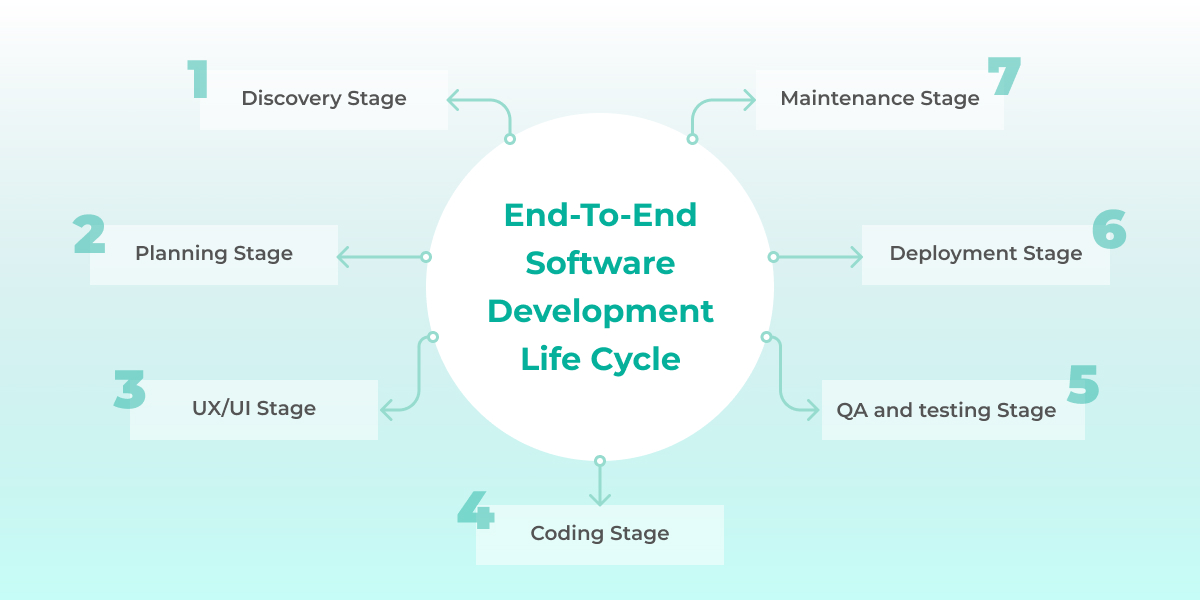Developing high-quality software products that meet the needs of clients and their customers requires a comprehensive approach to software development, known as end-to-end software development. This approach involves every stage of the development life cycle, from discovery and planning to deployment and maintenance.
In this guide to the end-to-end development process, we will explore the different stages of it in detail and provide insights and best practices to help businesses develop high-quality software products that meet their unique needs and goals. Whatever the size of your company, this guide will provide the tools and knowledge you need to succeed in today’s competitive digital world.
What Is End-to-end Software Development?
End-to-end software development is a comprehensive and all-encompassing approach to software development that has become increasingly popular in today’s fast-paced digital landscape. This approach involves a complete software development lifecycle, from ideation and conception to the final deployment of the software product, along with continuous maintenance and improvements over time. It emphasizes the involvement of a single team of developers or cross-functional teams responsible for every stage of software development. And it also includes planning, designing, developing, testing, deploying, and maintaining the software product.
In modern software development methodologies, such as agile, end-to-end software development has become the norm, facilitating faster, more efficient, and more effective software development. This approach gives organizations greater control over the software development process from start to finish. esulting in a more aligned, high-quality product that meets the needs of clients and their customers.
End-to-end software development relies on modern software development tools and technologies, such as integrated development environments (IDEs), version control systems, automated testing frameworks, and continuous integration and deployment (CI/CD) pipelines. These tools and technologies enable developers to work collaboratively, maintain version control, automate testing, and streamline the software development process to produce high-quality software products in less time.
End-to-end software development for businesses
This approach facilitates faster time-to-market, greater efficiency, and lower costs. It also ensures that the final software product meets the highest quality and user experience standards, resulting in greater customer satisfaction and loyalty. Additionally, it can help businesses maintain their competitive edge by developing unique, user-friendly software products that offer superior functionality compared to off-the-shelf solutions.
In conclusion, end-to-end software development is a powerful approach that can help businesses achieve their software development goals quickly, efficiently, and effectively. By adopting this approach, businesses can develop high-quality, unique software products that meet the needs of their clients and customers while also ensuring long-term success and growth in today’s fast-paced digital landscape.
Who Needs End-to-end Software Development?
End-to-end software development is a comprehensive approach that can help organizations of all sizes and types to create high-quality software products and services that meet their customers’ needs and the market’s demands. It would be especially valuable for a variety of organizations, including startups, mid-sized companies, and enterprise-level companies.
Startups
For startups, having a competitive edge is crucial to succeed in today’s market. One way to achieve this is by developing custom software products and services that stand out from the competition. However, startups often face challenges, such as limited resources, that can hinder the development process. This is where end-to-end development process comes into play.
End-to-end software development is a holistic approach that involves a complete software development lifecycle, from ideation and conception to final deployment and ongoing maintenance. This approach can benefit startups significantly, such as streamlining the development process and reducing costs. By involving a single team of developers or cross-functional teams responsible for every stage of software development, startups can save time and resources while still delivering high-quality products that meet their customer’s needs:
- End-to-end software development can help startups achieve faster time-to-market, a crucial factor in today’s competitive business landscape.
By following an agile methodology that emphasizes collaboration and continuous improvement, startups can develop unique software products that meet the needs of their customers quickly and efficiently. - Startups can benefit leveraging modern software development tools and technologies using end-to-end software development.
These tools include integrated development environments (IDEs), version control systems, automated testing frameworks, and continuous integration and deployment (CI/CD) pipelines. By utilizing these tools, startups can ensure the development process is streamlined, cost-effective, and efficient.
Mid-sized Companies
Mid-sized companies face unique challenges when it comes to software development. On the one hand, they may have in-house resources that can be utilized for development projects. On the other hand, they may lack the specialized expertise required for complex software development projects.
By adopting an end-to-end software development approach, mid-sized companies can leverage the expertise of a single team or cross-functional teams to guide them through every stage of the development life cycle. This approach provides the specialized expertise necessary to tackle complex development projects while also streamlining the development process.
- The ability to release or upgrade existing products faster and with fewer expenses is one of the key benefits of end-to-end software development for mid-sized companies. This is because the development process is streamlined and optimized for efficiency, focusing on delivering high-quality products that meet customer needs.
- Just like startups, mid-sized companies can benefit from it by utilizing modern tools and technologies. These tools include integrated development environments (IDEs), version control systems, automated testing frameworks, and continuous integration and deployment (CI/CD) pipelines. By leveraging these tools, mid-sized companies can ensure the development process is efficient and cost-effective.
- In addition, end-to-end software development can help mid-sized companies stay competitive in today’s fast-paced business landscape. By following an agile methodology that emphasizes collaboration and continuous improvement, these companies can create innovative software products that meet the needs of their customers quickly and efficiently.
In conclusion, end-to-end software development is a valuable approach for mid-sized companies. By leveraging specialized expertise and modern software development tools, these companies can streamline the development process, reduce costs, and release or upgrade products faster. This approach can help mid-sized companies stay competitive and achieve their business goals.
Enterprise-level Companies
Enterprise-level companies have unique requirements when it comes to software development. While some may have the resources to build their own in-house development teams, others may prefer to hire remote teams with specialized expertise in software development.
- As for enterprise-level companies, one of the key advantages is the ability to optimize resources. This is especially important for companies with limited resources or facing budget constraints. By working with remote teams, these companies can leverage the expertise of experienced professionals without the need to invest in additional resources.
- It can help enterprise-level companies maintain a stable brand reputation. This is because the development process focuses on delivering high-quality software products that meet customers’ needs. By leveraging modern software development tools and technologies, these companies can ensure that their software products meet the highest standards of quality and user experience.
Benefits of End-to-end Software Development
End-to-end software development offers a range of benefits to organizations that need to create high-quality software products and services. Some of the most significant benefits of this approach include:
- Result-oriented planning
The process involves careful planning and strategizing to ensure that the final product meets the needs of the client and their customers. This approach prioritizes results, which means that the development team will focus on delivering a product that meets the client’s objectives and business goals. - Better communication process
With an end-to-end software development approach, there is a strong emphasis on communication and collaboration between team members, stakeholders, and clients. This helps ensure everyone is on the same page throughout the development process, which can lead to better results and a more successful final product. - Compliance with the time schedule and budget
End-to-end software development involves careful project management and budgeting to ensure that the project is completed on time and within budget. This approach can help organizations avoid costly delays and ensure the final product is delivered on schedule. - Well-established workflow
The process typically involves a well-established workflow that is designed to optimize efficiency and productivity. This can help organizations to streamline their development process, reduce waste, and get their products to market faster. - Early bug detection
End-to-end software development involves rigorous testing and quality assurance throughout the development process. This can help to identify and address bugs and other issues early on, which can save time and money down the line. - Flexibility
End-to-end software development is a flexible approach that can be adapted to the needs of different organizations and projects. This allows organizations to customize the development process to meet their unique requirements and constraints, which can help to ensure that the final product meets their needs and exceeds their expectations.
Overall, this approach offers a range of benefits to organizations that need to create high-quality software products and services. By prioritizing planning, communication, compliance, workflow, bug detection, and flexibility, organizations can ensure that they develop software products that meet their business goals and satisfy their customers.
End-to-end Software Development Life Cycle Explained
End-to-end software development involves a comprehensive software development life cycle that encompasses all stages of the development process.

These stages typically include:
- Discovery.
In the discovery stage, the development team works closely with clients to understand their needs, business goals, and target audience. This involves conducting market research, identifying user personas, and defining the project’s scope. - Planning
In the planning stage, the development team creates a roadmap for the project, outlining the key milestones, deadlines, and deliverables. This involves identifying the development team, allocating resources, and creating a detailed project plan. - UX/UI
In the UX/UI stage, the development team designs the software product’s user experience and user interface. This involves creating wireframes, mockups, and prototypes and testing the design with real users. - Coding
In the coding stage, the development team writes the code for the software product. This involves using programming languages and tools to build the functionality of the product and integrating it with other systems and platforms as needed. - QA and testing
In the QA and testing stage, the development team tests the software product to identify and fix bugs and ensure that it meets the client’s requirements and the end-users’ needs. This involves a range of testing methodologies, including unit testing, integration testing, and acceptance testing. - Deployment
In the deployment stage, the development team deploys the software product to a live environment, making it available to end-users. This involves configuring servers, databases, and other systems and ensuring that the product is secure and scalable. - Maintenance
In the maintenance stage, the development team provides ongoing support and maintenance for the software product, ensuring it continues functioning as intended and addressing any issues that arise over time. This involves updating the software, fixing bugs, and responding to user feedback.
Overall, the end-to-end software development life cycle is a comprehensive approach to software development that involves careful planning, design, development, testing, deployment, and ongoing maintenance to create high-quality software products that meet the needs of clients and their customers. Each stage of the development process is crucial to the project’s success and requires specialized expertise and attention to detail to ensure that the final product is delivered on time, within budget, and to the highest quality standards.
Conclusion
End-to-end software development can be a perfect solution for businesses because it offers a comprehensive software development approach that involves every development life cycle stage, from discovery and planning to deployment and maintenance. By working with a team of experienced developers, businesses can ensure that their software products are designed to meet their unique needs, are developed on time and within budget, and are thoroughly tested to ensure quality and performance.
This approach also provides better communication and collaboration between the development team and the client, resulting in a product aligned with the business goals and meeting the end-users’ needs. Additionally, it allows businesses to maintain a competitive edge by developing software products that are unique, user-friendly, and offer superior functionality compared to off-the-shelf solutions.
Overall, it offers a range of benefits that can help businesses achieve their objectives and grow in today’s fast-paced and ever-changing digital landscape. Contact Bintime now to discuss your end-to-end software development needs and find the best solution for your business.











